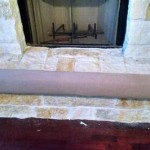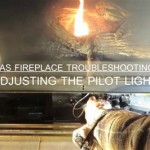Mantels Over Gas Fireplaces: A Comprehensive Guide
Gas fireplaces offer a convenient and efficient alternative to traditional wood-burning fireplaces, providing warmth and ambiance with ease. One of the key design considerations for any fireplace, gas or wood-burning, is the mantel. The mantel serves both a functional and aesthetic purpose, offering a surface for displaying decorative items while also enhancing the overall visual appeal of the fireplace and the room it occupies. When considering a mantel for a gas fireplace, several factors must be carefully evaluated, ranging from safety regulations and material selection to design compatibility and installation techniques.
The fundamental purpose of a mantel is to provide a focal point and a decorative element to the fireplace area. It's a platform for showcasing artwork, photographs, candles, and other personal items, allowing homeowners to personalize their living space. Beyond aesthetics, the mantel can also serve a more practical purpose by protecting the wall above the fireplace from the heat generated by the flames. It also allows for concealing wiring for a television mounted above the gas fireplace. Choosing the right mantel necessitates a balance between design preferences and the specific requirements of the gas fireplace installation.
Understanding Clearance Requirements and Safety Considerations
One of the most critical considerations when selecting and installing a mantel above a gas fireplace is adhering to the manufacturer's recommended clearance requirements. These requirements are established to prevent the mantel from overheating and potentially causing a fire. Gas fireplaces generate heat, and if a mantel is positioned too close to the firebox or flue, it can become a significant fire hazard. The specific clearance requirements vary depending on the model of the gas fireplace and the material used for the mantel.
Typically, gas fireplace manufacturers provide detailed specifications regarding the minimum distance required between the top of the firebox opening and the bottom of any combustible materials, including the mantel. This distance is usually expressed in inches, and it's crucial to consult the owner's manual or contact the manufacturer directly to obtain the correct figures for your specific gas fireplace model. Failure to comply with these clearance requirements can void the fireplace warranty and, more importantly, create a dangerous situation.
Building codes and regulations also play a significant role in determining the permissible placement of mantels above gas fireplaces. Local building authorities often adopt codes that specify the necessary clearances and material restrictions for fireplace installations. It is always recommended to consult with a qualified building inspector or a certified fireplace installer to ensure that the mantel installation complies with all applicable codes and regulations. This will help prevent any potential safety issues and ensure the long-term safety and functionality of the fireplace.
Furthermore, homeowners should be aware of the potential for convective heat transfer. Even if the mantel is positioned within the specified clearance requirements, it can still be affected by the heat rising from the fireplace. This is particularly true for mantels made of combustible materials such as wood. Over time, prolonged exposure to heat can cause wood to dry out, warp, or even ignite. To mitigate this risk, consider using non-combustible materials for the construction of the mantel, such as stone, brick, or specially treated wood that is fire-resistant.
Proper ventilation around the gas fireplace and mantel is essential for preventing overheating and ensuring safe operation. Ensure that the fireplace area is adequately ventilated to allow for the dissipation of heat. Avoid blocking any vents or openings that are designed to promote airflow. Regular maintenance of the gas fireplace, including cleaning the burner and venting system, can also help prevent excessive heat buildup and reduce the risk of fire.
Selecting the Right Mantel Material
The choice of material for a mantel above a gas fireplace is influenced by several factors, including aesthetics, budget, and safety considerations. Different materials offer varying levels of heat resistance, durability, and design flexibility. The most common materials used for mantels include wood, stone, brick, concrete, and metal. Each material has its own set of advantages and disadvantages, which should be carefully weighed before making a decision.
Wood is a popular choice for mantels due to its natural beauty, versatility, and relatively low cost. However, wood is a combustible material and requires proper treatment and installation to ensure safety. Hardwoods such as oak, maple, and cherry are generally preferred for their density and durability. Softwoods such as pine and fir can also be used, but they may require additional fireproofing or a greater distance from the firebox. When using wood for a mantel, it is essential to apply a fire-retardant coating to help protect it from heat and flames. Furthermore, adhering to the manufacturer's recommended clearance requirements is crucial to prevent overheating and potential fire hazards.
Stone mantels offer a timeless and elegant look while providing excellent heat resistance. Natural stones such as granite, marble, and limestone are popular choices for their durability and aesthetic appeal. Stone is a non-combustible material, making it a safe option for mantels above gas fireplaces. However, stone mantels can be relatively expensive and heavy, requiring professional installation to ensure proper support and stability. The weight of the stone must be adequately supported by the wall, and appropriate anchoring methods must be used to prevent the mantel from shifting or collapsing.
Brick is another durable and fire-resistant material that can be used for mantels. Brick mantels offer a rustic and traditional look, complementing a variety of architectural styles. Like stone, brick is a non-combustible material and provides excellent heat resistance. Brick mantels can be constructed using either new or reclaimed bricks, allowing for a customized and unique design. However, brick mantels can be relatively heavy and may require professional installation to ensure proper support and stability. The mortar used to bind the bricks together should also be heat-resistant to withstand the high temperatures generated by the gas fireplace.
Concrete mantels are becoming increasingly popular for their modern and industrial aesthetic. Concrete is a versatile material that can be molded into various shapes and sizes, allowing for customized designs. Concrete mantels are also relatively fire-resistant, although they may not be completely non-combustible depending on the specific composition of the concrete mix. When using concrete for a mantel, it is essential to ensure that the concrete is properly cured and sealed to prevent cracking and moisture absorption. The weight of the concrete mantel should also be carefully considered, and professional installation may be required to ensure proper support and stability.
Metal mantels, such as those made of steel or iron, offer a sleek and contemporary look while providing excellent heat resistance. Metal is a non-combustible material, making it a safe option for mantels above gas fireplaces. Metal mantels can be powder-coated or painted to match the surrounding decor. They can also be customized with various designs and finishes. However, metal mantels can become quite hot to the touch when the gas fireplace is in use, so it is important to consider this when designing the mantel area and to take precautions to prevent accidental burns.
Design Considerations and Installation Techniques
Beyond safety and material selection, the design and installation of a mantel above a gas fireplace play a crucial role in enhancing the overall aesthetic appeal of the room. The mantel should complement the architectural style of the home and the surrounding decor. It should also be appropriately sized and proportioned to the fireplace and the room it occupies. Careful planning and attention to detail are essential to achieve a cohesive and visually appealing result.
The style of the mantel should align with the overall design of the room. For example, a traditional home may benefit from a mantel made of ornate wood or classic stone, while a modern home may be better suited to a sleek metal or concrete mantel. The color and finish of the mantel should also complement the surrounding walls, flooring, and furniture. Consider using neutral colors or natural finishes to create a timeless and versatile look that will not clash with future decor changes.
The size and proportion of the mantel should be carefully considered in relation to the size of the fireplace and the room. A mantel that is too large can overwhelm the fireplace and make the room feel cramped, while a mantel that is too small may appear insignificant and out of place. As a general rule, the mantel should be slightly wider than the fireplace opening and should extend a few inches beyond the sides of the firebox. The height of the mantel should also be proportionate to the height of the fireplace and the ceiling height of the room.
Proper installation techniques are essential to ensure the safety, stability, and longevity of the mantel. Whether you are installing a wood, stone, brick, concrete, or metal mantel, it is crucial to follow the manufacturer's instructions and adhere to all applicable building codes and regulations. Ensure that the wall behind the fireplace is structurally sound and capable of supporting the weight of the mantel. Use appropriate anchoring methods, such as screws, bolts, or adhesive, to securely attach the mantel to the wall. For heavier mantels, it may be necessary to install additional support brackets or reinforcement to prevent sagging or collapse.
When installing a wood mantel, it is essential to ensure that it is properly sealed and protected from moisture. Apply a high-quality sealant to all surfaces of the wood to prevent water damage and warping. Consider using a fire-retardant coating to help protect the wood from heat and flames. When installing a stone or brick mantel, use a heat-resistant mortar to bind the materials together. Ensure that the mortar joints are properly filled and sealed to prevent moisture penetration and cracking. When installing a metal mantel, be sure to ground the mantel to prevent electrical shock. Use insulated connectors and wiring to prevent short circuits and electrical hazards.
Finally, consider the placement of electrical outlets and wiring in relation to the mantel. If you plan to mount a television or other electronic devices above the fireplace, ensure that there are adequate electrical outlets and wiring to accommodate them. Conceal the wiring behind the mantel or within the wall to create a clean and uncluttered look. It is always recommended to consult with a qualified electrician to ensure that all electrical work is performed safely and in compliance with applicable codes and regulations.

Types Of Fireplaces And Mantels The Home Depot

Types Of Fireplaces And Mantels The Home Depot

Imperial Keenan Mantels Mi Gas Fireplace Mantel Toronto Best

Marquess Keenan Mantels Mm Gas Fireplace Mantel Toronto Best

Fireplace Mantels Overmantels And Surrounds Omega Linear Living Room Decor Bookcase

Terrific White Mantel Fireplace Fine Decoration 1000 Ideas About Mantels On Classic Living Room Home Family Design

Types Of Fireplaces And Mantels The Home Depot
Fireplace Mantles Custom Made Barnwood By Century Home Renos Chr Contact Us Today 905 259 7307 Handcrafted Furnishings Timber Framing

ᑕ❶ᑐ How High Should A Mantel Be Above An Electric Fireplace

10 Fireplace Mantel Decorating Ideas Full Service Chimney
Related Posts








